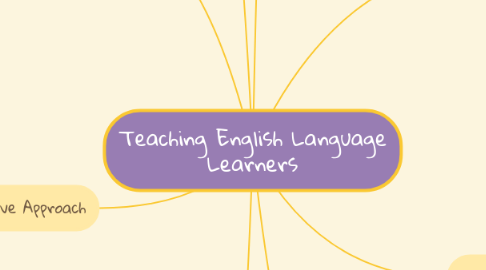
1. Classroom Environment
1.1. Visuals in the Classroom
1.1.1. Posters, labels, texts
1.2. Strategic Grouping
1.2.1. Partnering lower level students with higher level students and seating plans
1.3. Respecting Silent Period
1.3.1. Providing opportunities to speak without stress
1.4. Kind/Welcoming Attitude
1.4.1. Body Language, facial expression, speech
1.5. Providing Listening/Speaking Opportunities
1.5.1. Games and beginning of class activities (two circles)
2. Literacy
2.1. Reading & Writing
2.1.1. Writing Prompts
2.1.2. Sentence Frames
2.1.3. Read-a-loud
2.2. Listening & Speaking
2.2.1. Diction
2.2.2. Conversation for pronounciation
2.2.3. Films, Music, Advertising
3. Teaching Strategies
3.1. Inductive learning
3.1.1. Students formulate underlying pattern
3.1.2. Data Sets
3.1.3. Student Centred Approach
3.2. Deductive Learning
3.2.1. Students are given an explanation
3.2.2. Teacher Centred Approach
3.2.3. Students begin with rules
4. Communicative Approach
4.1. Inclusivity
4.1.1. Include first language
4.1.2. Acknowledge Cultural Holidays
4.1.3. Include Cultural Content
4.1.4. Avoid Tokenism
4.2. Communication between students and between the teacher
4.2.1. Plenty of opportunities to speak
4.2.2. Mistakes are encouraged
4.2.3. Gestures
4.2.4. Constant interaction with English
4.2.5. Videos, pictures, text
5. Assessment
5.1. Wiggins' 7 Keys For Effective Feedback
5.1.1. Timely
5.1.2. Friendly
5.1.3. Consistant
5.1.4. Constructive
5.2. Formative
5.2.1. Throughout a unit
5.2.2. Variety of forms
5.2.3. Shows knowledge and understanding
5.3. Summative
5.3.1. At the END of unit
5.3.2. Includes aspects from the whole unit
5.3.3. Graded with feedback for final mark
6. Who are ELLs?
6.1. New Comers to Ontario
6.1.1. Refugees or Immigrants
6.2. International or Visa Students
6.2.1. Students studying abroad either in highs school or post secondary
6.3. Canadian Born Students
6.3.1. Students who are born in Canada with gaps in language
7. Language Proficiency
7.1. BICS
7.1.1. Basic Interpersonal Communicative Skills
7.1.2. The language skills used in everyday communication
7.1.3. Working in general jobs
7.2. CALPS
7.2.1. Cognitive Academic Language Proficiency
7.2.2. The language used in academic environments
7.2.3. Vocabulary specific to field of study
8. Error Correction
8.1. Clarification Request
8.1.1. Give clarification kindly and with context and consideration as students are speaking
8.2. Rephrase
8.2.1. Be sure to use appropriate vocabulary
8.3. Written Feedback
8.3.1. So students can go over their feedback and continue to grow

